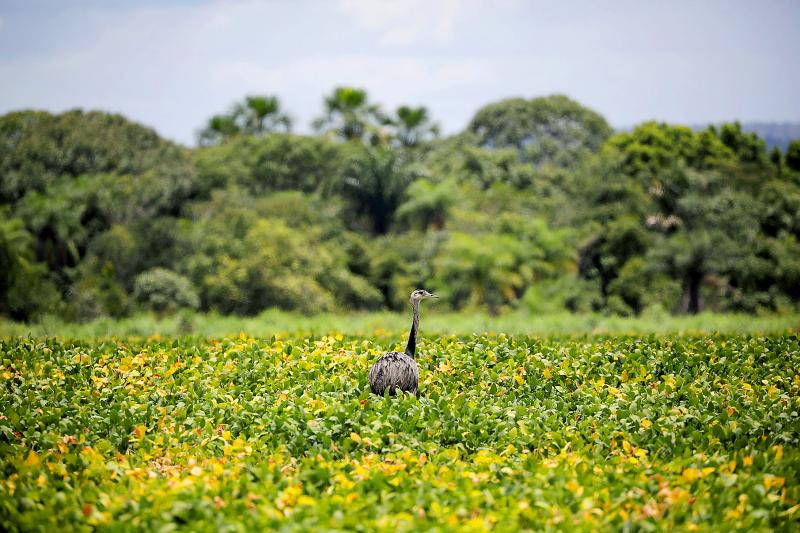More bad weather for the world’s oilseed growers is pushing rapeseed and canola prices to fresh records and adding to food inflation worries.
Futures have been on a tear for a while, after last year’s harvests in Canada and Europe were plagued by scorching drought and planting cutbacks, cutting global rapeseed stockpiles to a four-year low.
Worries are mounting about supplies of rival vegetable oils, with hot and dry weather hurting South American soybean prospects and flooding hitting palm oil farms in Malaysia.

Photo: Reuters
As a recent crude oil rally also aids demand for the crops to make biodiesel, Paris rapeseed futures and North American canola notched new all-time highs on Friday. Their oils are also used for everything from frying French fries to mixing salad dressings. Rapeseed prices have nearly doubled in the past year.
“The situation is really tight, and the buyers are still there,” said Arthur Portier, an analyst at Paris-based farm adviser Agritel.
Paris rapeseed futures surged as much as 5.9 percent on Friday, the biggest intraday gain since 2009, and North American canola gained as much as 1.5 percent.
The gains come as palm oil — used in about half of all supermarket goods — has rallied and near-record food prices squeeze household budgets.
A UN index of food prices averaged 28 percent higher last year than the prior year, led by a surge in vegetable oils.
Europe has become increasingly reliant on oilseed imports in the past few years, after phasing out crop chemicals that rapeseed growers used to deter pests.
That is exacerbating local prices, as supplies shrink across key exporters, said Michael Magdovitz, senior analyst at Rabobank NV in London.
The situation could improve later this year. France and Germany have increased plantings, government data show.
Canadian farmers are also likely to plant more canola as wheat prices retreat, said Charlie Sernatinger, global head of grain futures at ED&F Man Capital Markets Inc in Chicago.
The world’s largest soybean producer and exporter is expected to fail to deliver a record crop this year.
Crop forecasters have slashed their estimates for Brazil’s soy output as persistent drought and heat caused losses in the nation’s south. Production is seen below last year’s level, when the South American nation reaped 137.3 million tons (139.5 million metric tonnes). The harvest could have reached as much as 145 million tons this season, according to initial forecasts.
Concerns over the South America crop have caused a rally in Chicago, with soybean futures rising 13 percent since the beginning of last month.
Brazil’s lower production is also likely to curb its shipments and might increase the competitiveness of US exports.
Heat and dry conditions were intense last month in Brazil’s south, a region accounting for about one-third of the nation’s crop. That led brokerage StoneX to cut its production estimate by 7.7 percent to 134 million tons earlier this week.
On Thursday, the local consultancy AgRural said output might be even lower at 133.4 million tons.
Argentina, also a major supplier of the oilseed, faces a similar weather pattern, with moisture deficits reaching at least 75 percent of the nation’s soy next week, the Commodity Weather Group said.
The reviews made this week on Brazil’s crop estimates might signal official cuts next week, when the US Department of Agriculture and Brazil’s Conab are scheduled to release forecasts for the nation’s crop.
Other commodities:
‧Gold for February delivery on Friday rose US$8.20 to US$1,797.40 an ounce, down 1.7 percent for the week.
‧Silver for March delivery rose US$0.22 cents to US$22.41 an ounce, down 4 percent weekly, and Marchcopperrose US$0.06 to US$4.41 a pound, down 1 percent for the week.
Additional reporting by AP

Intel Corp chief executive officer Lip-Bu Tan (陳立武) is expected to meet with Taiwanese suppliers next month in conjunction with the opening of the Computex Taipei trade show, supply chain sources said on Monday. The visit, the first for Tan to Taiwan since assuming his new post last month, would be aimed at enhancing Intel’s ties with suppliers in Taiwan as he attempts to help turn around the struggling US chipmaker, the sources said. Tan is to hold a banquet to celebrate Intel’s 40-year presence in Taiwan before Computex opens on May 20 and invite dozens of Taiwanese suppliers to exchange views

Application-specific integrated circuit designer Faraday Technology Corp (智原) yesterday said that although revenue this quarter would decline 30 percent from last quarter, it retained its full-year forecast of revenue growth of 100 percent. The company attributed the quarterly drop to a slowdown in customers’ production of chips using Faraday’s advanced packaging technology. The company is still confident about its revenue growth this year, given its strong “design-win” — or the projects it won to help customers design their chips, Faraday president Steve Wang (王國雍) told an online earnings conference. “The design-win this year is better than we expected. We believe we will win

Chizuko Kimura has become the first female sushi chef in the world to win a Michelin star, fulfilling a promise she made to her dying husband to continue his legacy. The 54-year-old Japanese chef regained the Michelin star her late husband, Shunei Kimura, won three years ago for their Sushi Shunei restaurant in Paris. For Shunei Kimura, the star was a dream come true. However, the joy was short-lived. He died from cancer just three months later in June 2022. He was 65. The following year, the restaurant in the heart of Montmartre lost its star rating. Chizuko Kimura insisted that the new star is still down

While China’s leaders use their economic and political might to fight US President Donald Trump’s trade war “to the end,” its army of social media soldiers are embarking on a more humorous campaign online. Trump’s tariff blitz has seen Washington and Beijing impose eye-watering duties on imports from the other, fanning a standoff between the economic superpowers that has sparked global recession fears and sent markets into a tailspin. Trump says his policy is a response to years of being “ripped off” by other countries and aims to bring manufacturing to the US, forcing companies to employ US workers. However, China’s online warriors